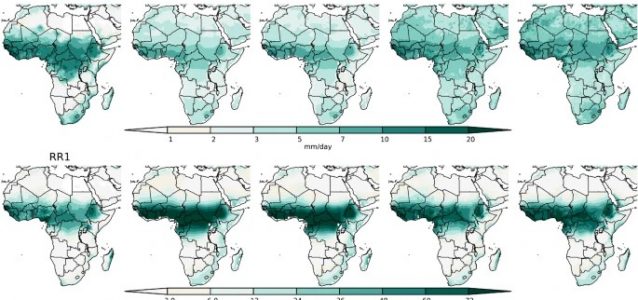Projected future daily characteristics of African precipitation based on global (CMIP5, CMIP6) and regional (CORDEX, CORDEX-CORE) climate models
We provide an assessment of future daily characteristics of African precipitation by explicitly comparing the results of large ensembles of global (CMIP5, CMIP6) and regional (CORDEX, CORE) climate models, specifically highlighting the similarities and inconsistencies between them. Results for seasonal mean precipitation are not always consistent amongst ensembles: in particular, global models tend to project a wetter future compared to regional models, especially over the Eastern Sahel, Central and East Africa. However, results for other precipitation characteristics are more consistent. In general, all ensembles project an increase in maximum precipitation intensity during the wet season over all regions and emission scenarios (except the West Sahel for CORE) and a decrease in precipitation frequency (under the Representative Concentration Pathways RCP8.5) especially over the West Sahel, the Atlas region, southern central Africa, East Africa and southern Africa. Depending on the season, the length of dry spells is projected to increase consistently by all ensembles and for most (if not all) models over southern Africa, the Ethiopian highlands and the Atlas region. Discrepancies exist between global and regional models on the projected change in precipitation characteristics over specific regions and seasons. For instance, over the Eastern Sahel in July–August most global models show an increase in precipitation frequency but regional models project a robust decrease. Global and regional models also project an opposite sign in the change of the length of dry spells. CORE results show a marked drying over the regions affected by the West Africa monsoon throughout the year, accompanied by a decrease in mean precipitation intensity between May and July that is not present in the other ensembles. This enhanced drying may be related to specific physical mechanisms that are better resolved by the higher resolution models and highlights the importance of a process-based evaluation of the mechanisms controlling precipitation over the region.
Paper Link:
Dosio, A., Jury, M.W., Almazroui, M. Ashfaq, M., Diallo, I., Engelbrecht, F.A., Klutse, N.A.B., Lennard, C., Pinto, I., Sylla, M.B. and Tamoffo, A.T. 2021. Projected future daily characteristics of African precipitation based on global (CMIP5, CMIP6) and regional (CORDEX, CORDEX-CORE) climate models. Climate Dynamics.
